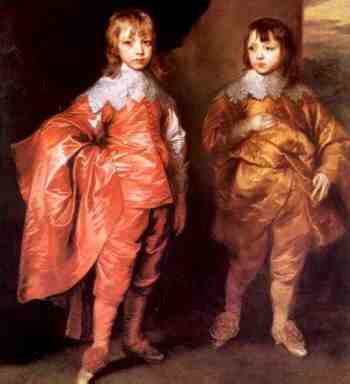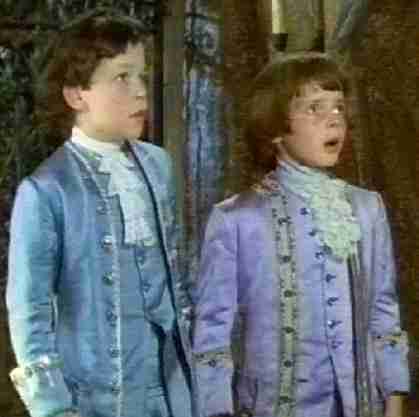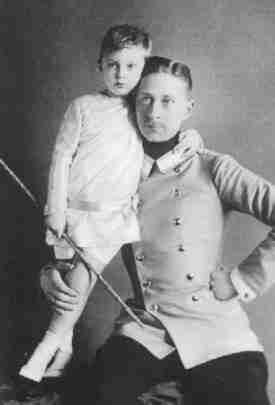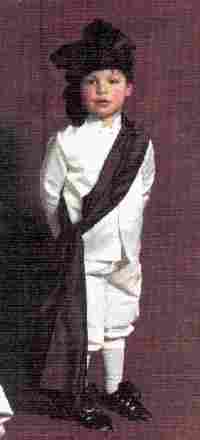
Fabrics Used in Boys' Clothing: Satin

Figure 1.--These English Cavalier boys are pictured in the elaborate lace-trimmed satin suits of the 17th Century. These are not boy's suits, but the same style as worn by their fathers. I don't have details
yet on this painting, but it may be a Van Dyck work.
|
Chronology
The history of satin is inextricably linked to the history of silk from which all true satin is made. Silk was developed in China, about the 27th Century. The Chinese for an
amazing 30 Centuries kept the secret of silk. The secret was finally brought to Europe in the 6th Century AD by the Emperor Justinian and a silk industry soon flourished in Asian Minor (Turkey).
The 14th-16th centuries
Silk production did not begin in Europe proper until about the 14th Century. Production began in northern Europe and subsequently southern France. The domestic production of silk considerably lowered the cost of silk and satin in Europe. While still expensive and limited to use in luxury garments for the wealthy, they were no longer as expensice as in the past. The price of silk in Europe was once an equivalent weight in gold. Thus
silk and satin became increasingly after domestiv production began.
Satin itself was first produced in China, although I have no details on this yet. I do not have details on how and when the technology of making satin was trnasferred to Europe, althoug satin is a wpven product so Europeans would have had no difficulty producing it once the silk thread was available.

Figure 2.--This English movie portrays satin suits worn by boys in the 18th Century. Movie costuming is notoriously unreliable, but these costumes do appear to be accurate period pieces. Again they were the
same style of suits worn by their fathers. Boys by the end of the decade were wearing specialized children's clothes like skeleton suits.
|
The 17th century
I'm not sure when it first appeared in Europe, but it was commonly worn by wealthy Europeans by the 17th Century. At the time there were no specialized chldren's clothes, but some boys wore satin suits modeled on the clothes worn by their fathers. These suits were often worn with expensive lace and ruffle
trim.
European styles of the day often originated in Italy. The most important court of the 17th Century was the French court of Louis XIV. To keep the French nobility from stirring up trouble in the provinces, he bought them to France and placed great emphasis on ritual and clothing. The fancy outfits inclued suits made of satin and other luxurious gabrics and heavily trimmed in lace and ruffles. It was the French fashions that influenced English fashions and the Stuart court and Cavalier
fashions.
The 18th century
Some boys wore satin skeleton suits in the late 18th and early 19th Century. Satin was not one of the more common materials for skeleton suits. However some expensive suits for dress occasions were made of satin.
The 19th century
I am not sure about the use of satin in the 19th Century. Boys' fashions at the begiining and mid-centery tended to be rather plain so presumably it was not widely used. Some younger boys might wear satin dresses or dresses with satin trim before breeching.
The 20th century
Satin outfits were primarily in the 20th Century worn for very dressy occasions, such as weddings. Dressy boys outfits, however were not often made of satin,
especially in the United States.

Figure 3.--The German crown prince is pictured here in a short pants satin suit. Despite the age differences, he and his brothers were often dressed alike in this and similar suits with open square collars. Tunic outfits for boys always had belts. The princes' suit has a decorative ribbon instead of an actual belt.
|
The German princes at the turn of the 20th Century wore satin short pants play suit. One style was rather like a tunic outfit, but with a very short tunic
and short pants rather than bloomer style knickers. The princes also wore similar satin outfits with open square collars. I'm not sure what how common satin was
used for such garments. It is likely it was mostly used by royal and aristocratic children and other children from very wealthy families.
Fabric
Silk
True satin is made from silk. It is a woven fabric characteristic by a glossy face and a smooth, soft slippery texture. Satin has a silk-like luster. The warp and weft threads in a "satin weave" are closely and uniformely interwoven in such a way that the upper surface of the fabric consists mostly of the warp threads. In a satin weave structure the weft (horizontal) threads float over the tops of groups
of warp (vertical) threads creating a smooth and shiny cloth. The relections of light by the even, smooth surface of warp threads gives satin its distinctive brilliance and luster. The under side of the fabric is dull and trilled.
Satin is not particularlydurable. Certainly not the most suitable fabric for boys' clothes. It is more commonly used for women's clothing, bed spreads and
draperies, coat linings as well as the linings of arrticles such as luggage and jewelry boxes.
Satin crepe
Satin crepe, a reversible fabric, is woven with loosely twisted reeled thread for the warp and creped thread for the weft. The face of the facric is thus lustrous and smooth and the back of the fabric is a dull crepe.

Figure 4.--This American boy wears a fancy satin knicker suit for his part in a wedding. The formal clothes worn at weddings are often the fanciest clothes worn by boys.
|
Cotton sateen
Sateen is an immitation, less expensive substitute made of cotton. It is woven with weft threads on the top surface and the warp threads in the back. Sateen is
not as klustrous as true satin, but is more durable. It is also used for clothing and linings.
Synthetic Fibers
Modern satin is generally made from synthetic fibers (including acetate, rayon, nylon), as well as silk.
Acetate
Celanese Acetate History:
1905: Camille and Henri Dreyfus develop commercial process to manufacture cellulose acetate.
1910: Cellulose acetate commercially used to make films, toilet articles and molded articles. Product is also sold to aircraft industry to coat fabrics on airplane wings and fuselage.
1913: Camille and Henri Dreyfus start producing acetate fibers in their laboratories.
1921: Dreyfus Brothers develop dry spinning technique that allows fiber to be knit and woven for apparel.
1924: First commercial acetate filament spun in the U.S. at Cumberland, Maryland.
1925: Celanese, a word combining cellulose with the feeling of comfort and ease, is introduced as a trade name. Celanese Acetate fabrics are sold in silk constructions, such as taffeta, satin, ninon, voile, and crepe.
1925: Camille Dreyfus introduces modern fiber merchandising to major department stores. Celanese Acetate is introduced as "Artificial Silk."
1930's: Acetate introduced for apparel linings.
1928: 48 Celanese Acetate manufacturing facilities open in Drummondville, Canada; Narrows, Virginia; Ocotlan, Mexico and Rock Hill, South Carolina.
1965: Celanese Acetate manufacturing facility opens in Lanaken, Belgium.
1987: Top designers use Celanese Acetate for women's evening wear, women's sportswear, men's wear and children's apparel. Designers who use acetate include Anne Klein II, Carolina Herrera, Nicole Miller, Andrea Jovine, a.b.s. of California, Betsey Johnson, Leon Max, Chanel, Carmen Marc Valvo, Giorgio Armani The Collection, Ellen Tracy, Badgley Mischka, and Tadashi.
1992: Kristi Yamaguchi introduced as fashion spokesperson for Celanese Acetate.
1994: MicroSafe antimicrobially-treated acetate introduced.
1997: Cellulose Acetate Business of Hoechst named Celanese Acetate.
Rayon
Nylon
Garments
Satin is an expensive fabric and only used in costly garments. Caviliers, both adults and boys, might wear satin coats and breeches. Satin was often used for
sashes decorating fancy suits like Little Lord Fauntleroy suits in the late 19th Century. Boys suits with open necks were sometimes made of satin. European royalty often used satin, even for childrens as recently as the 20th Century until World War I (1914-18).
Christopher Wagner
histclo@lycosmail.com
Navigate the Boys' Historical Clothing Web Site:
[Return to the Main fabric page]
[Introduction]
[Chronology]
[Clothing styles]
[Biographies]
[Bibliographies]
[Contributions]
[Activities]
[Countries]
[Boys' Clothing Home]
Navigate the Historic Boys' Clothing Web chronological pages:
[The 1840s]
[The 1900s]
[The 1930s]
[The 1940s]
[The 1950s]
[The 1960s]
[The 1970s]
[The 1980s]
[The 1990s]
Created: April 5, 1999
Last updated: December 1, 1999





